Digs & Discoveries
Guardian Feline
By JASON URBANUS
Friday, April 10, 2020
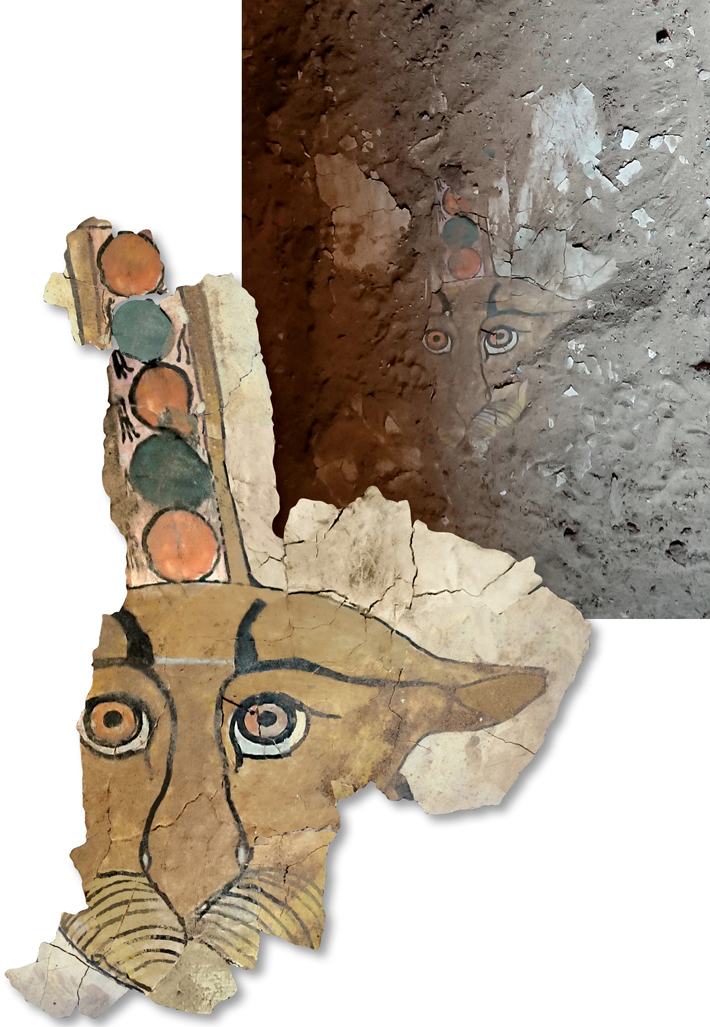 For more than 1,000 years, Egyptians buried their dead at the Aswan necropolis, on the banks of the Nile. In one tomb, which contained as many as 30 bodies, a joint Italian-Egyptian team recently noticed a painted leopard’s face peering at them from the soil. The painting, which may once have decorated the lid of a sarcophagus, is in an extremely delicate state of preservation, making it difficult to remove. Now the researchers have digitally reconstructed the face of the painted feline, which accompanied one ancient Egyptian’s journey to the afterlife around 2,100 years ago. “We understood that the very fragile piece of wood could be restored and returned back to its original splendor,” says University of Milan archaeologist Patrizia Piacentini. “For the moment, the restoration is only virtual, but we hope to get the same results with an actual restoration.” In ancient Egypt, the leopard was a symbol of power and strength. Egyptologists believe the painted animal’s face would have been positioned directly above the deceased’s head to provide guidance and protection in the afterlife.
For more than 1,000 years, Egyptians buried their dead at the Aswan necropolis, on the banks of the Nile. In one tomb, which contained as many as 30 bodies, a joint Italian-Egyptian team recently noticed a painted leopard’s face peering at them from the soil. The painting, which may once have decorated the lid of a sarcophagus, is in an extremely delicate state of preservation, making it difficult to remove. Now the researchers have digitally reconstructed the face of the painted feline, which accompanied one ancient Egyptian’s journey to the afterlife around 2,100 years ago. “We understood that the very fragile piece of wood could be restored and returned back to its original splendor,” says University of Milan archaeologist Patrizia Piacentini. “For the moment, the restoration is only virtual, but we hope to get the same results with an actual restoration.” In ancient Egypt, the leopard was a symbol of power and strength. Egyptologists believe the painted animal’s face would have been positioned directly above the deceased’s head to provide guidance and protection in the afterlife.
Off the Grid
By MARLEY BROWN
Friday, April 10, 2020
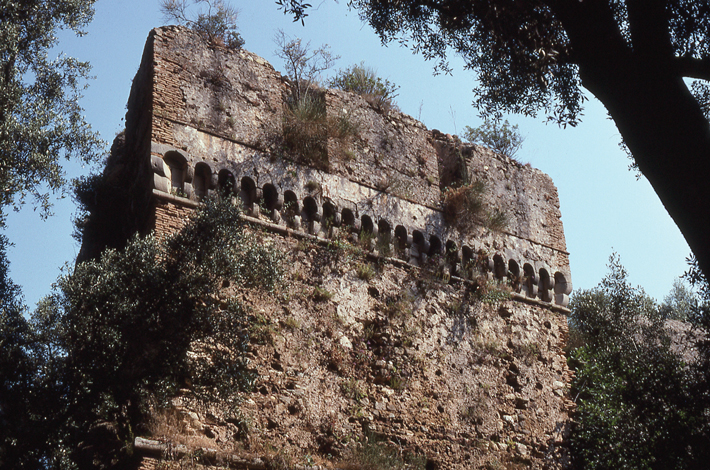 Roughly 1,000 feet above sea level in the hilly interior of Calabria—the toe of Italy’s boot—the town of Oppido Mamertina is surrounded by ancient forested terrain. The modern town is the successor to a medieval town called Oppido Vecchio that was destroyed by an earthquake in 1783, and whose evocative ruins still stand for visitors to admire. These include town gates and streets, and cloisters built by religious orders. There is also a castle, dating to the eleventh-century Norman conquest of southern Italy, which was periodically renovated according to the shifting fashions of the times until the seventeenth century.
Roughly 1,000 feet above sea level in the hilly interior of Calabria—the toe of Italy’s boot—the town of Oppido Mamertina is surrounded by ancient forested terrain. The modern town is the successor to a medieval town called Oppido Vecchio that was destroyed by an earthquake in 1783, and whose evocative ruins still stand for visitors to admire. These include town gates and streets, and cloisters built by religious orders. There is also a castle, dating to the eleventh-century Norman conquest of southern Italy, which was periodically renovated according to the shifting fashions of the times until the seventeenth century.
Archaeologists have discovered that the area was home to Iron Age settlements dating back far earlier, to at least the seventh century B.C. In the late fourth century B.C., Oscan-speaking Italic peoples indigenous to southern Italy moved into the area, which, at the time, was controlled by the coastal Greek colony of Locri, some 15 miles away. One such group, the Tauriani, built a large town at the site of Contrada Mella, a short walk downhill from Oppido Vecchio. “The Tauriani do not appear to have fought against the nearby Greeks,” says archaeologist Paolo Visonà of the University of Kentucky. “They somehow established themselves in the region and developed a multifaceted relationship with their Greek neighbors. In fact, I think they constructed a unique identity out of their entanglement with both Greek and local Italic communities.” Examples of Greek influence found at Contrada Mella include aspects of town planning, masonry styles, a wealth of Greek coins, and decorative imagery inspired by Greek theater. Visonà believes it is possible the Tauriani came to the area as mercenaries hired to defend Locri’s interests against both Greek and indigenous rivals. After initially supporting the Carthaginian general Hannibal, the Tauriani formed a judicious alliance with the Roman Republic during the Second Punic War (218–201 B.C.). Possibly through the largesse of the victorious Romans, they subsequently expanded Contrada Mella.
THE SITE
Begin your trip with a visit to the archaeology museum in the city of Reggio Calabria for a primer on local history and Tauriani culture. After a drive of an hour or so northeast to Oppido Mamertina, signs in the main square provide directions to Oppido Vecchio, and an interpretive display offers guidance for a self-directed tour. While Contrada Mella is mostly overgrown, the site can be seen by looking downhill from the medieval ruins.
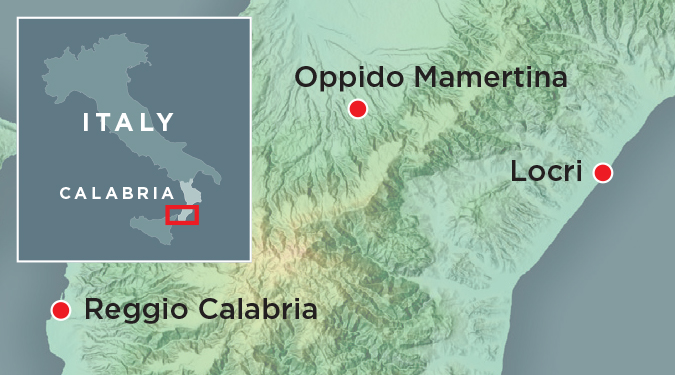 WHILE YOU’RE THERE
WHILE YOU’RE THERE
To fully appreciate the mélange of cultures in Calabria more than 2,000 years ago, continue east from Oppido Mamertina to the coast and visit the archaeological park of ancient Locri, where, in addition to several excellent seaside restaurants, you will find the remains of a once-grand theater and Ionic temple. Be sure to visit cdc.gov/travel for updates on health risks in the area.
The Parthenon by Any Other Name?
By JASON URBANUS
Friday, April 10, 2020
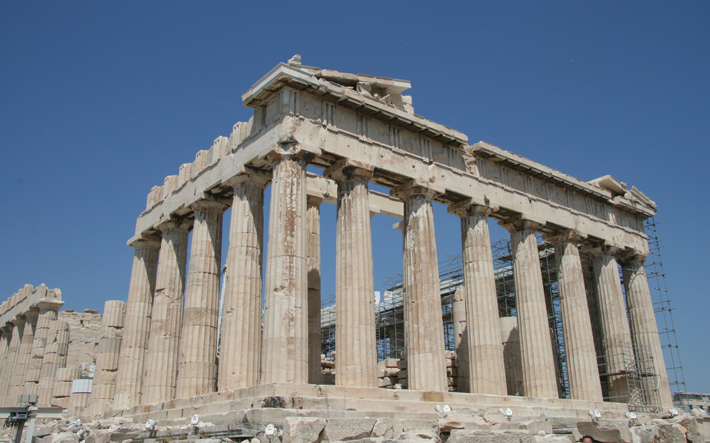 The Parthenon on the Athenian Acropolis is one of the best-known buildings of the ancient world. Yet, despite its renown, it turns out that for more than 2,000 years, we may have been calling the temple by the wrong name. “I knew that scholars didn’t really understand why it’s called the Parthenon,” says Utrecht University archaeologist Janric van Rookhuijzen, “so I started looking into a giant puzzle of ancient texts, inscriptions, and archaeological remains.” His surprising, perhaps even heretical, theory suggests that “Parthenon” may not have originally referred to the structure we know today—which is sometimes called the Great Temple of Athena—but to part of an altogether different temple on the Acropolis.
The Parthenon on the Athenian Acropolis is one of the best-known buildings of the ancient world. Yet, despite its renown, it turns out that for more than 2,000 years, we may have been calling the temple by the wrong name. “I knew that scholars didn’t really understand why it’s called the Parthenon,” says Utrecht University archaeologist Janric van Rookhuijzen, “so I started looking into a giant puzzle of ancient texts, inscriptions, and archaeological remains.” His surprising, perhaps even heretical, theory suggests that “Parthenon” may not have originally referred to the structure we know today—which is sometimes called the Great Temple of Athena—but to part of an altogether different temple on the Acropolis.
For van Rookhuijzen, the crux of the issue lies in the meaning of the Greek word parthenon—“a room for virgins or unwed maidens.” The first use of this term in reference to a building on the Acropolis appears in inscriptions dating to 434 B.C. At the time, the temples of the Acropolis were not only religious sanctuaries, but also served as banks and trophy rooms where gold and silver, jewelry, precious artifacts, and spoils of war were stored. Athenian officials took detailed annual inventories of these treasures, noting exactly where each was kept. They listed locations including the opisthodomos, “back room,” proneos, “front porch,” hekatompedos, “100-foot-long room,” and parthenon.
Although modern scholars have not always agreed on the location and identification of each of these rooms, almost all have assumed that “parthenon” must refer to the building we know as the Parthenon today, an association that van Rookhuijzen finds problematic. It has long been assumed that the Great Temple of Athena derived its nickname, the Parthenon, from the immense chryselephantine, or gold and ivory, statue of Athena Parthenos, or “Virgin Athena,” that once stood in the building’s large eastern cella. But van Rookhuijzen has found there is actually very little evidence to support this explanation for the structure’s name, and that there are no strong indications that the Great Temple of Athena was frequently occupied or used by maidens, virgins, or priestesses.
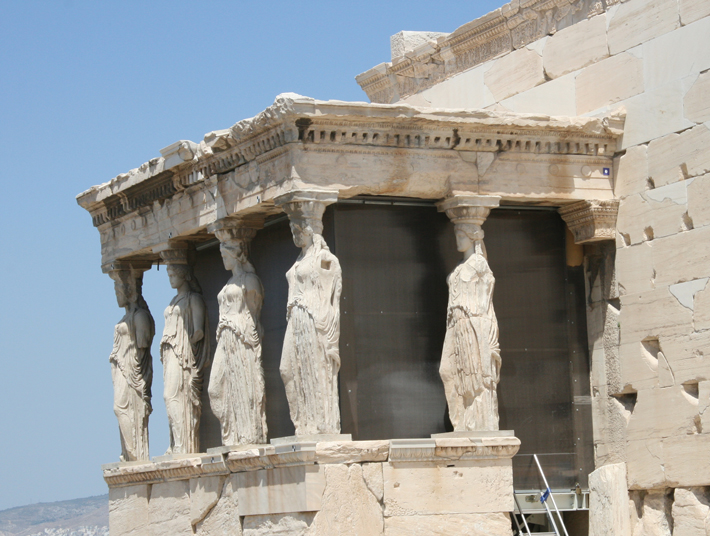 There is, however, according to van Rookhuijzen, another building on the Acropolis, not far from the Great Temple of Athena, that better suits the definition of a parthenon. This is the enigmatic sacred complex known conventionally, but, says van Rookhuijzen, probably erroneously, as the Erechtheion. It includes six larger-than-life-size sculpted female figures called caryatids, thought to represent mythological maidens (parthenoi), that serve as the columns supporting the porch’s roof. Archaeological evidence has shown that the Erechtheion was also once amply decorated with a number of carved female figures. In this sacred space, young virgin priestesses performed religious rites, and some may have even lived there. “In the true sense of the word, this part of the building was a real ‘parthenon,’” says van Rookhuijzen.
There is, however, according to van Rookhuijzen, another building on the Acropolis, not far from the Great Temple of Athena, that better suits the definition of a parthenon. This is the enigmatic sacred complex known conventionally, but, says van Rookhuijzen, probably erroneously, as the Erechtheion. It includes six larger-than-life-size sculpted female figures called caryatids, thought to represent mythological maidens (parthenoi), that serve as the columns supporting the porch’s roof. Archaeological evidence has shown that the Erechtheion was also once amply decorated with a number of carved female figures. In this sacred space, young virgin priestesses performed religious rites, and some may have even lived there. “In the true sense of the word, this part of the building was a real ‘parthenon,’” says van Rookhuijzen.
The Acropolis treasure inventories from the fifth and fourth centuries B.C. document specific objects that were stored in the parthenon, including pieces of furniture and armor seized from the Persians after they were defeated in the 479 B.C. Battle of Plataea. Many hundreds of years later, the second-century A.D. writer and traveler Pausanias visited Athens and seems to have described seeing the very same objects that had centuries earlier been inventoried as “in the Parthenon,” not in the building we call the Parthenon today, but in the caryatid building. “It’s unlikely that the treasures were moved from one place to another,” says van Rookhuijzen. “Therefore, the parthenon should be known as part of the caryatid temple.”
Van Rookhuijzen understands that not everyone will agree with his hypothesis, but is pleased to have sparked renewed discussions about the topography of the Athenian Acropolis. “The Parthenon means so much to so many people, both in Greece and in the rest of the world,” he says. “I don’t see it as my task to dictate what others should believe, but rather to offer material for contemplation and discussion, and to invite others to investigate the roots of our knowledge of this complex, fascinating site.”
Advertisement
Advertisement
IN THIS ISSUE
Digs & Discoveries
The Parthenon by Any Other Name?
Off the Grid
Guardian Feline
The Cursing Well
If These Walls Could Talk
Warrior Stone
At Press Time
Polychrome Patchwork
Scaredy Cats
Arms and the Women
Birds of a Feather
Viking Knights, Polish Days
Z Marks the Spot
Around the World
Neanderthal clam divers, bananas in Vanuatu, the Maya Great Road, and a secret door in Parliament
Artifact
An emblem of endurance
Advertisement

Recent Issues
-
 May/June 2024
May/June 2024
-
 March/April 2024
March/April 2024
-
 January/February 2024
January/February 2024
-
 November/December 2023
November/December 2023
-
 September/October 2023
September/October 2023
-
 July/August 2023
July/August 2023
-
 May/June 2023
May/June 2023
-
 March/April 2023
March/April 2023
-
 January/February 2023
January/February 2023
-
 November/December 2022
November/December 2022
-
 September/October 2022
September/October 2022
-
 July/August 2022
July/August 2022
-
 May/June 2022
May/June 2022
-
 March/April 2022
March/April 2022
-
 January/February 2022
January/February 2022
-
 November/December 2021
November/December 2021
-
 September/October 2021
September/October 2021
-
 July/August 2021
July/August 2021
-
 May/June 2021
May/June 2021
-
 March/April 2021
March/April 2021
-
 January/February 2021
January/February 2021
-
 November/December 2020
November/December 2020
-
 September/October 2020
September/October 2020
-
 July/August 2020
July/August 2020
-
 May/June 2020
May/June 2020
-
 March/April 2020
March/April 2020
-
 January/February 2020
January/February 2020
-
 November/December 2019
November/December 2019
-
 September/October 2019
September/October 2019
-
 July/August 2019
July/August 2019
-
 May/June 2019
May/June 2019
-
 March/April 2019
March/April 2019
-
 January/February 2019
January/February 2019
-
 November/December 2018
November/December 2018
-
 September/October 2018
September/October 2018
-
 July/August 2018
July/August 2018
-
 May/June 2018
May/June 2018
-
 March/April 2018
March/April 2018
-
 January/February 2018
January/February 2018
-
 November/December 2017
November/December 2017
-
 September/October 2017
September/October 2017
-
 July/August 2017
July/August 2017
-
 May/June 2017
May/June 2017
-
 March/April 2017
March/April 2017
-
 January/February 2017
January/February 2017
-
 November/December 2016
November/December 2016
-
 September/October 2016
September/October 2016
-
 July/August 2016
July/August 2016
-
 May/June 2016
May/June 2016
-
 March/April 2016
March/April 2016
-
 January/February 2016
January/February 2016
-
 November/December 2015
November/December 2015
-
 September/October 2015
September/October 2015
-
 July/August 2015
July/August 2015
-
 May/June 2015
May/June 2015
-
 March/April 2015
March/April 2015
-
 January/February 2015
January/February 2015
-
 November/December 2014
November/December 2014
-
 September/October 2014
September/October 2014
-
 July/August 2014
July/August 2014
-
 May/June 2014
May/June 2014
-
 March/April 2014
March/April 2014
-
 January/February 2014
January/February 2014
-
 November/December 2013
November/December 2013
-
 September/October 2013
September/October 2013
-
 July/August 2013
July/August 2013
-
 May/June 2013
May/June 2013
-
 March/April 2013
March/April 2013
-
 January/February 2013
January/February 2013
-
 November/December 2012
November/December 2012
-
 September/October 2012
September/October 2012
-
 July/August 2012
July/August 2012
-
 May/June 2012
May/June 2012
-
 March/April 2012
March/April 2012
-
 January/February 2012
January/February 2012
-
 November/December 2011
November/December 2011
-
 September/October 2011
September/October 2011
-
 July/August 2011
July/August 2011
-
 May/June 2011
May/June 2011
-
 March/April 2011
March/April 2011
-
 January/February 2011
January/February 2011
Advertisement






